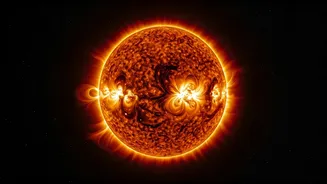The Solar Enigma
The sun, our nearest star, has always fascinated humankind. While its surface temperature hovers around 5,500 degrees Celsius, the sun's outer atmosphere,
the corona, surprisingly reaches millions of degrees Celsius. This dramatic temperature difference has been a major scientific puzzle for years. Standard physics could not explain how energy could be transferred from the relatively cool surface to the scorching corona. This disparity, the 'coronal heating problem,' has been at the forefront of solar physics research, with scientists seeking to understand the mechanism behind this unusual thermal behaviour. Explanations varied, from the possibility of magnetic fields playing a role, to the impact of solar flares and other phenomena. Each suggested explanation required a deep dive into the sun's complex processes.
New Research Insights
Recent research has put forward a promising explanation for the sun's incredibly hot corona. Scientists have looked to the continuous movement of the sun’s magnetic field lines, suggesting that they might play a key part in the heating mechanism. These dynamic fields, constantly twisting and reconnecting, generate tremendous amounts of energy. This energy, released in the form of heat, is responsible for the elevated temperatures observed in the corona. Researchers have been using advanced computer models, as well as observations from solar observatories, to explore the interplay between the magnetic field and the temperature. These models are crucial in simulating and understanding the intricate mechanisms at play within the sun's environment, providing detailed insights into the energy transfer processes.
Magnetic Field's Role
The movement of the sun’s magnetic field lines is the core of this new explanation. The sun's magnetic field isn't uniform; it's a complex web of magnetic lines that twist and loop through the sun's surface and atmosphere. As these lines move, they create what are known as magnetic reconnections. During these events, the magnetic field lines break and quickly reform, releasing a burst of energy. This energy is then converted into heat. This process occurs constantly across the sun's surface, contributing to the extremely high temperatures. The frequency and intensity of these reconnections can vary, which could explain why the corona's temperature also fluctuates. The intricate details of this process, including the exact location and timing of the magnetic reconnections, are still being researched.
Observational Evidence
Confirming the theory requires detailed observations and analysis. Researchers are using advanced instruments, like those found on solar observatories, to study the sun’s magnetic field in great detail. These observatories utilize a range of sensors to observe various properties of the sun, including magnetic field strength, density, and temperature. Sophisticated instruments allow scientists to monitor the magnetic fields and measure the heat distribution in the corona. Data is collected across different wavelengths of light, helping them map the dynamic changes. By correlating data on the magnetic fields and coronal temperatures, scientists can test and refine their models. It's a collaborative effort, combining observation with theoretical modeling. The ongoing work will provide more insights into the relationship between magnetic field activity and coronal heating, leading to a deeper understanding.
Implications and Future
The implications of these findings are significant. A more accurate understanding of the coronal heating mechanism allows us to better understand the sun's role in space weather. These models can also help forecast solar flares and coronal mass ejections, which can affect satellites and disrupt terrestrial communication. Looking ahead, future research will likely delve into more sophisticated models, incorporating a deeper exploration of the energy release and transfer processes. Scientists also plan to incorporate high-resolution observations to monitor events across the sun. This research could reshape our understanding of not only the sun, but also the broader physics of stars and plasmas throughout the universe. Moreover, a comprehensive understanding of solar activity will refine space weather predictions and improve our ability to protect our infrastructure from potentially damaging solar events.











